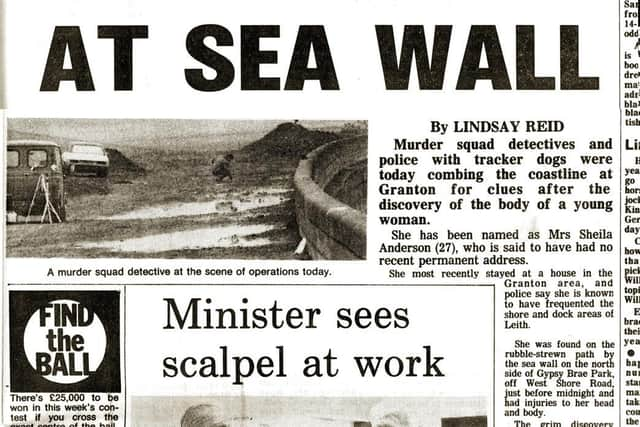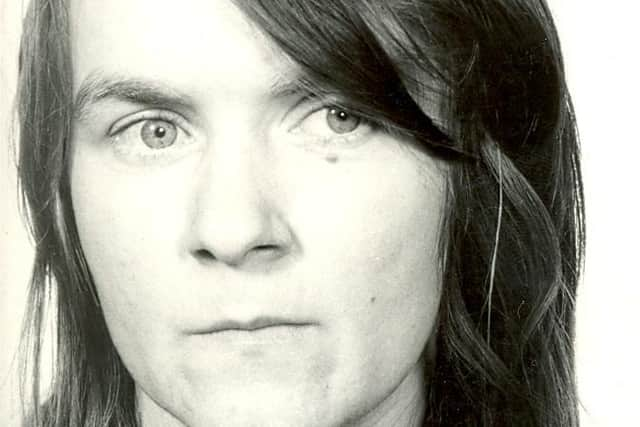Former top cop reveals secrets of policing Edinburgh's violent and burgeoning sex trade


The 27-year-old mother of two had been repeatedly run over by a car and, although police identified a DNA profile in 2009, her killer has never been caught.
For Ritchie, long since retired from the force where he reached the rank of Detective Superintendent, the case has become an integral part of his latest project, a history of Edinburgh’s sex-trade. It’s a book he is co-writing with former Lothian and Borders’ Deputy Police Chief Tom Wood and one that will see the pair speaking to sex workers and recording their experiences.
Advertisement
Hide AdAdvertisement
Hide Ad“Although it will chart the history of sex work in the city over the last 200 years, it is starting in 1983 with the murder of Sheila because it remains unsolved,” explains Peter. “Tom and I both worked on that case. It ran for a good few weeks but then, when Caroline Hogg went missing, all the resources shifted...”


Thoughtfully, he adds, “It would be different now, we actually learned quite a lot from that one. We also realised how little intelligence we had from that world. Most time we were reactive - when someone got killed or battered, we reacted. After the murder of Sheila we became more proactive, particularly Tom when he reached policy-making level, he was the great architect of the tolerance zones.”
If the killing of Sheila changed attitudes in the Force, creating an understanding that they had a duty of care the ‘girls’ on the street, public perception remained resistant to change.
“One of the hardest things from that period was getting the public on board when a sex worker was killed,” says Peter. "In most cases you are overwhelmed by good will, people wanting to help, but with a sex-worker there was an element of ‘well she asked for it’, so it was very difficult to get huge waves of public sympathy unless you could change that perception.”
Advertisement
Hide AdAdvertisement
Hide AdHe continues, “It’s interesting, when you go back to those times, which are not all that long ago, the difference in attitudes to so many subjects is quite incredible”.


A time of rapid change, the policing landscape evolved beyond all recognition in the Eighties and the author reflects, “When I went in, nothing had changed since the 1930s.
“We bridged the period when tape-recording came in, there was the controversy about rape inquiries, forensic science, DNA... scientists taking over crime scenes rather than the cops.
"I always tell the story of an early case I went to when a really senior detective came in flicking his fag ash everywhere and actually trailing a bit of gore about on the back of his shoe. That could never happen now. The one thing they did do on the Sheila Anderson case, which didn’t always happen back then, was close the investigation down quite carefully so that the evidence available was preserved.”
Advertisement
Hide AdAdvertisement
Hide AdOne of the transformations that came from that case was that, “we had to try and make sure that the girls were safe, rather than trying to drive them into the shadows,” he adds.


Today, the Capital’s sex-trade is very different. The Internet has seen a shift in focus, but while you may be less likely to see a sex-worker plying their trade on the street, the industry is more lucrative than ever it seems.
“It has all changed because so much of it is now online...” explains Peter. “The local element is still there, it has to be, for a lot of women that’s how they have to earn, but you’ll not see as many on the street now because men invariably tend to go to their laptop first, but while it’s not as visible, one thing is for sure, it is a lot bigger. It’s huge.”
Today’s sex industry is controlled by international operations that traffic sex-workers from city to city on a regular basis, and Edinburgh plays its part, says the writer.
Advertisement
Hide AdAdvertisement
Hide Ad“It’s everywhere, many of these girls are trafficked on a regular basis, week to week, from Edinburgh to Dublin, Manchester, Belfast, where ever... they’re moving about all the time.


“Looking at Edinburgh alone, there is no way the size of its current sex-trade was replicated 20 or 30 years ago.
“What we are hoping to do in the book is to get a better grip on what is actually happening because the potential for violence is always there, and the levels of violence can be incredible.”
It was all very different back in Fifties, Sixties and Seventies when local ‘brothels’ were common place in the Capital, with none more famous than Dora’s, on Danube Street. Dora Noyce operated as a madam from 17 Danube Street, Stockbridge, where it is said 15 resident prostitutes worked, with others called in when the business was busy. Noyce famously claimed she was at her busiest during the Festival and when the General Assembly of the Church of Scotland was in session.
Advertisement
Hide AdAdvertisement
Hide Ad“Based on the many, many women in the trade I have spoken to over the years, I’ve come to realise so many sex workers are ordinary people just like you and me but for a turn of fortune. I’ve always said there but for the grace of God...” considers Peter.
“When Tom and I were talking about that, we got on to Dora’s, which was on Tom’s beat at one time. Dora cultivated the homely approach, but I think she was a bit of a one-off to be honest. It’s no secret that she was not unfriendly to the police - for all the times that she was taken to court it wasn’t like she was dragged their kicking and screaming. She would always argue she was providing a public service.
“One of the things Tom has discovered from that time is that brothels in Edinburgh, and apparently it was the same in Dora’s, kept the top floor for the ‘high heid-yins’, the bottom floor for the ‘you and me’.”
By the Eighties, Edinburgh sex-trade had taken a much darker turn, being fuelled as it was by city’s burgeoning heroin scene.
Advertisement
Hide AdAdvertisement
Hide Ad“At the time Sheila was murdered, almost every girl was a junkie. It was an awful period and we weren’t helping,” admits Peter, candidly, explaining “the drug squad were taking everybody’s needles away... we didn’t know.”
Despite the desperate nature of the trade, a gallow’s humour developed between the ‘working girls’ and police officers.
“When we were taking statements, despite it being such a serious subject, it could become a comedy when the girls got talking about their punters and the variety of life they came in contact with.
“They all had nicknames for their clients, I remember I got a job of tracing a guy known as The Torchman. We found him eventually and that was his thing, he always had a torch and liked to ‘look up’... That was it. I remember the girl saying, ‘Well, it was easy money’.
Advertisement
Hide AdAdvertisement
Hide Ad“Another I remember had a thing about horses; he’d pick up a girl and drive into the country where they’d watch horses. Again, easy money. In between, of course, they’d get the violent characters, there was this complete contrast, and they never knew what they were going to get next.”
Peter’s experience of policing the city’s sex-trade runs through his latest novel, Maxine’s Story, first published as a novella in 2015. Now fleshed out, it tells the story of Maxine Welsh, a poor soul who works the streets of Leith while her world collapses around her thanks to addiction and debt.
It’s a story that the writer of the best-selling Detective Grace Maccallan series felt he had to share, and one he intends will give something back - profits from its sale will be donated to Scot-Pep, the Edinburgh sex worker-led charity that advocates for the safety, rights and health of everyone who sells sex in Scotland.
He explains, “I never wanted to make anything from Maxine’s Story, but because of the response to the novella I thought I’d go back and rewrite it as a full book and keep control of it by self-publishing. So it’s never been about making money and I’ve always said if I get sales I’ll make a donation to Scot-Pep or one of the relevant charities."
Advertisement
Hide AdAdvertisement
Hide AdHe adds, “I’ve tried to make the characters very human as I’ve always had a thing about the lack of understanding surrounding sex workers. They are the most misunderstood. They are not seen as real people and that’s why the dedication in the book reads: ‘For the women who have no voice’.”
Maxine’s Story, by Peter Ritchie is available now in paperback, priced £8.99